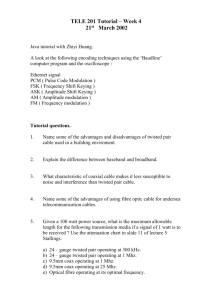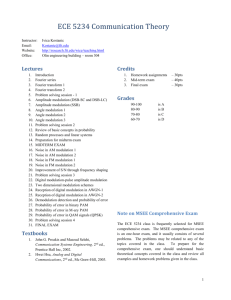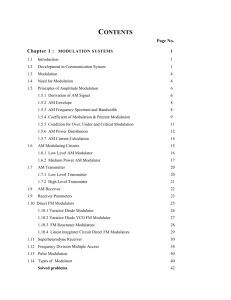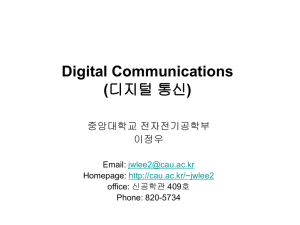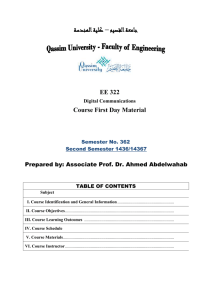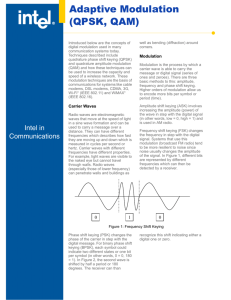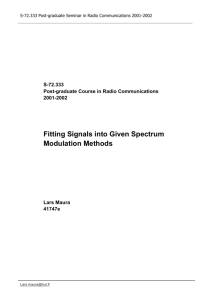ECE 660
advertisement
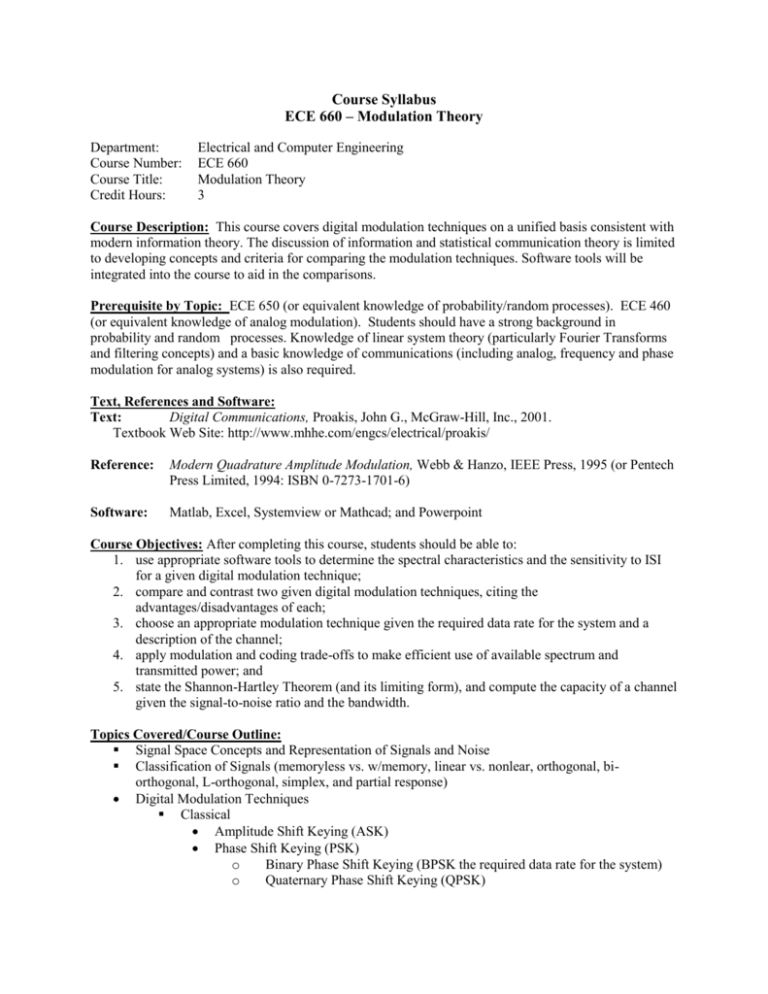
Course Syllabus ECE 660 – Modulation Theory Department: Course Number: Course Title: Credit Hours: Electrical and Computer Engineering ECE 660 Modulation Theory 3 Course Description: This course covers digital modulation techniques on a unified basis consistent with modern information theory. The discussion of information and statistical communication theory is limited to developing concepts and criteria for comparing the modulation techniques. Software tools will be integrated into the course to aid in the comparisons. Prerequisite by Topic: ECE 650 (or equivalent knowledge of probability/random processes). ECE 460 (or equivalent knowledge of analog modulation). Students should have a strong background in probability and random processes. Knowledge of linear system theory (particularly Fourier Transforms and filtering concepts) and a basic knowledge of communications (including analog, frequency and phase modulation for analog systems) is also required. Text, References and Software: Text: Digital Communications, Proakis, John G., McGraw-Hill, Inc., 2001. Textbook Web Site: http://www.mhhe.com/engcs/electrical/proakis/ Reference: Modern Quadrature Amplitude Modulation, Webb & Hanzo, IEEE Press, 1995 (or Pentech Press Limited, 1994: ISBN 0-7273-1701-6) Software: Matlab, Excel, Systemview or Mathcad; and Powerpoint Course Objectives: After completing this course, students should be able to: 1. use appropriate software tools to determine the spectral characteristics and the sensitivity to ISI for a given digital modulation technique; 2. compare and contrast two given digital modulation techniques, citing the advantages/disadvantages of each; 3. choose an appropriate modulation technique given the required data rate for the system and a description of the channel; 4. apply modulation and coding trade-offs to make efficient use of available spectrum and transmitted power; and 5. state the Shannon-Hartley Theorem (and its limiting form), and compute the capacity of a channel given the signal-to-noise ratio and the bandwidth. Topics Covered/Course Outline: Signal Space Concepts and Representation of Signals and Noise Classification of Signals (memoryless vs. w/memory, linear vs. nonlear, orthogonal, biorthogonal, L-orthogonal, simplex, and partial response) Digital Modulation Techniques Classical Amplitude Shift Keying (ASK) Phase Shift Keying (PSK) o Binary Phase Shift Keying (BPSK the required data rate for the system) o Quaternary Phase Shift Keying (QPSK) o M-ary Phase Shift Keying (MPSK) Frequency Shift Keying (FSK) Quadrature Amplitude Modulation (QAM) Advanced Digital Modulation Techniques Differential Phase Shift Keying (DPSK) Continuous Phase FSK (CPFSK) Continuous Phase Modulation (CPM) Minimum Shift Keying (MSK) o Gaussian MSK (GMSK) Offset or staggered QPSK (OQPSK or SQPSK) /4-QPSK Differential /4-QPSK (D-/4-QPSK) Orthogonal Frequency Division Modulation (OFDM) Discrete Multitone (DMT) Trellis-Coded Modulation (TCM) Star QAM and Star-Differential QAM (Star D-QAM) Variable Rate QAM Optimum Receivers Shannon-Hartley Theorem Concepts and Metrics for Comparison Power spectra, spectral characterizations, sidelobe regrowth Bandwidth efficiency (bps/Hz) Performance in AWGN (and sometimes fading) Sensitivity to Intersymbol Interference (ISI) Comparison Tools (in Matlab and/or SystemView by Elanix) Eye Diagrams Scatter Diagrams (signal & noise) Signal Space Diagrams with Transitions Phase Tree Spectrum Analyzer Oral Reports: Each student will be required to present an oral report to the class (using Powerpoint or any software presentation tool) covering one of the digital modulation techniques or software tools listed above in the section Topics to be Covered. Relationship to Program Outcomes: This course supports the achievement of the following outcomes: a) Ability to apply knowledge of advanced principles to the analysis of electrical and computer engineering problems. b) Ability to apply knowledge of advanced techniques to the design of electrical and computer engineering systems. c) Ability to apply the appropriate industry practices, emerging technologies, state-of-the-art design techniques, software tools, and research methods of solving electrical and computer engineering problems. d) Ability to use the appropriate state-of-the-art engineering references and resources, including IEEE research journals and industry publications, needed to find the best solutions to electrical and computer engineering problems. e) Ability to communicate clearly and use the appropriate medium, including written, oral, and electronic communication methods. f) Ability to maintain life-long learning and continue to be motivated to learn new subjects. g) Ability to learn new subjects that are required to solve problems in industry without being dependent on a classroom environment. h) Ability to be competitive in the engineering job market or be admitted to an excellent Ph. D. program. Prepared by: Debbie van Alphen November 8, 2002

